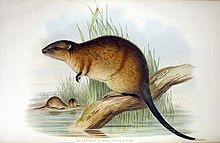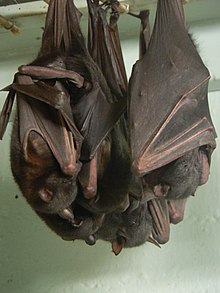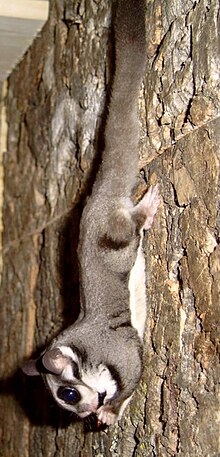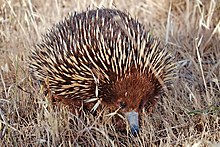Subclass: Theria
Infraclass: Eutheria
Order: Sirenia (manatees and dugongs)

Sirenia is an order of fully aquatic, herbivorous mammals that inhabit rivers, estuaries, coastal marine waters, swamps, and marine wetlands. All four species are endangered.
- Family: Dugongidae
Order: Rodentia (rodents)


Rodents make up the largest order of mammals, with over 40% of mammalian species. They have two incisors in the upper and lower jaw which grow continually and must be kept short by gnawing.
- Suborder: Sciurognathi
- Family: Muridae (mice, rats, voles, gerbils, hamsters, etc.)
- Subfamily: Murinae
- Genus: Anisomys
- Squirrel-toothed rat, Anisomys imitator LR/lc
- Genus: Chiruromys
- Greater tree mouse, Chiruromys forbesi LR/lc
- Lamia, Chiruromys lamia LR/lc
- Lesser tree mouse, Chiruromys vates LR/lc
- Genus: Coccymys
- Rümmler's brush mouse, Coccymys ruemmleri LR/lc
- Genus: Conilurus
- Brush-tailed rabbit rat, Conilurus penicillatus LR/lc
- Genus: Crossomys
- Earless water rat, Crossomys moncktoni LR/lc
- Genus: Hydromys
- Water rat, Hydromys chrysogaster LR/lc
- Western water rat, Hydromys hussoni LR/nt
- New Britain water rat, Hydromys neobrittanicus VU
- Genus: Baiyankamys
- Mountain water rat, Baiyankamys habbema LR/nt
- Shaw Mayer's water rat, Baiyankamys shawmayeri LR/nt
- Genus: Hyomys
- Western white-eared giant rat, Hyomys dammermani LR/lc
- Eastern white-eared giant rat, Hyomys goliath LR/lc
- Genus: Leptomys
- Long-footed water rat, Leptomys elegans CR
- Ernst Mayr's water rat, Leptomys ernstmayri LR/lc
- Fly River water rat, Leptomys signatus CR
- Genus: Lorentzimys
- New Guinean jumping mouse, Lorentzimys nouhuysi LR/lc
- Genus: Macruromys
- Eastern small-toothed rat, Macruromys major EN
- Genus: Mallomys
- De Vis's woolly rat, Mallomys aroaensis LR/lc
- Subalpine woolly rat, Mallomys istapantap LR/nt
- Rothschild's woolly rat, Mallomys rothschildi LR/lc
- Genus: Mammelomys
- Large-scaled mosaic-tailed rat, Mammelomys lanosus LR/lc
- Large mosaic-tailed rat, Mammelomys rattoides LR/lc
- Genus: Melomys
- Bougainville mosaic-tailed rat, Melomys bougainville LR/nt
- Grassland mosaic-tailed rat, Melomys burtoni LR/lc
- Red-bellied mosaic-tailed rat, Melomys fellowsi VU
- Slender mosaic-tailed rat, Melomys gracilis LR/lc
- White-bellied mosaic-tailed rat, Melomys leucogaster LR/lc
- Long-nosed mosaic-tailed rat, Melomys levipes LR/lc
- Lorentz's mosaic-tailed rat, Melomys lorentzii LR/lc
- Thomas's mosaic-tailed rat, Melomys mollis LR/lc
- Moncton's mosaic-tailed rat, Melomys moncktoni LR/lc
- Lowland mosaic-tailed rat, Melomys platyops LR/lc
- Mountain mosaic-tailed rat, Melomys rubex LR/lc
- Black-tailed mosaic-tailed rat, Melomys rufescens LR/lc
- Genus: Microhydromys
- Musser's shrew mouse, Microhydromys musseri LR/lc
- Groove-toothed shrew mouse, Microhydromys richardsoni LR/nt
- Genus: Parahydromys
- New Guinea waterside rat, Parahydromys asper LR/lc
- Genus: Paraleptomys
- Northern water rat, Paraleptomys rufilatus LR/lc
- Short-haired water rat, Paraleptomys wilhelmina VU
- Genus: Pogonomelomys
- Grey pogonomelomys, Pogonomelomys brassi LC
- Lowland brush mouse, Pogonomelomys bruijni CR
- Shaw Mayer's brush mouse, Pogonomelomys mayeri LR/lc
- Highland brush mouse, Pogonomelomys sevia LR/lc
- Genus: Pogonomys
- Champion's tree mouse, Pogonomys championi VU
- Large tree mouse, Pogonomys loriae LR/lc
- Chestnut tree mouse, Pogonomys macrourus LR/lc
- Gray-bellied tree mouse, Pogonomys sylvestris LR/lc
- Genus: Pseudohydromys
- One-toothed shrew-mouse, Pseudohydromys ellermani VU
- Mottled-tailed shrew mouse, Pseudohydromys fuscus VU
- German's one-toothed moss mouse, Pseudohydromys germani
- Eastern shrew mouse, Pseudohydromys murinus CR
- Western shrew mouse, Pseudohydromys occidentalis VU
- Genus: Pseudomys
- Little native mouse, Pseudomys delicatulus LR/nt
- Genus: Rattus
- Polynesian rat, Rattus exulans LR/lc
- Giluwe rat, Rattus giluwensis LR/nt
- Cape York rat, Rattus leucopus LR/lc
- Eastern rat, Rattus mordax LR/lc
- New Guinean rat, Rattus novaeguineae LR/lc
- Large New Guinea spiny rat, Rattus praetor LR/lc
- Dusky field rat, Rattus sordidus LR/nt
- Stein's rat, Rattus steini LR/lc
- Genus: Solomys
- Poncelet's naked-tailed rat, Solomys ponceleti EN
- Bougainville naked-tailed rat, Solomys salebrosus LR/nt
- Isabel naked-tailed rat, Solomys sapientis VU
- Genus: Stenomys
- Moss-forest rat, Stenomys niobe LR/lc
- Van Deusen's rat, Stenomys vandeuseni EN
- Slender rat, Stenomys verecundus LR/lc
- Genus: Uromys
- Giant naked-tailed rat, Uromys anak LR/nt
- Giant white-tailed rat, Uromys caudimaculatus LR/lc
- Bismarck giant rat, Uromys neobritanicus LR/lc
- Genus: Xenuromys
- Rock-dwelling rat, Xenuromys barbatus LR/nt
- Genus: Xeromys
- False water rat, Xeromys myoides VU
- Genus: Anisomys
- Subfamily: Murinae
- Family: Muridae (mice, rats, voles, gerbils, hamsters, etc.)
Order: Chiroptera (bats)



The bats' most distinguishing feature is that their forelimbs are developed as wings, making them the only mammals capable of flight. Bat species account for about 20% of all mammals.
- Family: Pteropodidae (flying foxes, Old World fruit bats)
- Subfamily: Pteropodinae
- Genus: Aproteles
- Bulmer's fruit bat, Aproteles bulmerae CR
- Genus: Dobsonia
- Lesser naked-backed fruit bat, Dobsonia minor LR/nt
- Moluccan naked-backed fruit bat, Dobsonia moluccensis LR/lc
- Panniet naked-backed fruit bat, Dobsonia pannietensis LR/lc
- New Britain naked-backed fruit bat, Dobsonia praedatrix LR/nt
- Genus: Nyctimene
- Broad-striped tube-nosed fruit bat, Nyctimene aello LR/nt
- Common tube-nosed fruit bat, Nyctimene albiventer LR/lc
- Pallas's tube-nosed fruit bat, Nyctimene cephalotes LR/lc
- Mountain tube-nosed fruit bat, Nyctimene certans LR/nt
- Round-eared tube-nosed fruit bat, Nyctimene cyclotis LR/nt
- Dragon tube-nosed fruit bat, Nyctimene draconilla VU
- Island tube-nosed fruit bat, Nyctimene major LR/lc
- Demonic tube-nosed fruit bat, Nyctimene masalai VU
- Umboi tube-nosed fruit bat, Nyctimene vizcaccia LR/lc
- Genus: Paranyctimene
- Unstriped tube-nosed bat, Paranyctimene raptor LR/nt
- Genus: Pteralopex
- Bougainville monkey-faced bat, Pteralopex anceps CR
- Genus: Pteropus
- Admiralty flying-fox, Pteropus admiralitatum LR/lc
- Black flying-fox, Pteropus alecto LR/lc
- Spectacled flying-fox, Pteropus conspicillatus LR/lc
- Gilliard's flying-fox, Pteropus gilliardorum VU
- Small flying-fox, Pteropus hypomelanus LR/lc
- Big-eared flying fox, Pteropus macrotis LR/lc
- Lesser flying-fox, Pteropus mahaganus VU
- Bismarck flying-fox, Pteropus neohibernicus LR/lc
- Little red flying-fox, Pteropus scapulatus LR/lc
- Temminck's flying fox, Pteropus temminckii LR/nt
- Insular flying-fox, Pteropus tonganus LR/lc
- Genus: Rousettus
- Geoffroy's rousette, Rousettus amplexicaudatus LR/lc
- Genus: Aproteles
- Subfamily: Macroglossinae
- Genus: Macroglossus
- Long-tongued nectar bat, Macroglossus minimus LR/lc
- Genus: Melonycteris
- Black-bellied fruit bat, Melonycteris melanops LR/lc
- Genus: Syconycteris
- Common blossom-bat, Syconycteris australis LR/lc
- Moss-forest blossom bat, Syconycteris hobbit VU
- Genus: Macroglossus
- Subfamily: Pteropodinae
- Family: Vespertilionidae
- Subfamily: Kerivoulinae
- Genus: Kerivoula
- St. Aignan's trumpet-eared bat, Kerivoula agnella VU
- Fly River trumpet-eared bat, Kerivoula muscina VU
- Bismarck's trumpet-eared bat, Kerivoula myrella VU
- Genus: Phoniscus
- Golden-tipped bat, Phoniscus papuensis LR/lc
- Genus: Kerivoula
- Subfamily: Myotinae
- Genus: Myotis
- Large-footed bat, Myotis adversus LR/lc
- Peters's myotis, Myotis atra LR/lc
- Whiskered myotis, Myotis muricola LR/lc
- Genus: Myotis
- Subfamily: Vespertilioninae
- Genus: Chalinolobus
- Hoary wattled bat, Chalinolobus nigrogriseus LR/lc
- Genus: Nycticeius
- Northern broad-nosed bat, Nycticeius sanborni LR/lc
- Genus: Nyctophilus
- Eastern long-eared bat, Nyctophilus bifax LR/lc
- Gould's long-eared bat, Nyctophilus gouldi LR/lc
- Small-toothed long-eared bat, Nyctophilus microdon VU
- New Guinea long-eared bat, Nyctophilus microtis LR/lc
- Greater long-eared bat, Nyctophilus timoriensis VU
- Genus: Pharotis
- New Guinea big-eared bat, Pharotis imogene CR
- Genus: Philetor
- Rohu's bat, Philetor brachypterus LR/lc
- Genus: Pipistrellus
- Angulate pipistrelle, Pipistrellus angulatus LR/lc
- Greater Papuan pipistrelle, Pipistrellus collinus LR/lc
- Lesser Papuan pipistrelle, Pipistrellus papuanus LR/nt
- Watt's pipistrelle, Pipistrellus wattsi LR/nt
- Genus: Chalinolobus
- Subfamily: Murininae
- Genus: Murina
- Flores tube-nosed bat, Murina florium LR/lc
- Genus: Murina
- Subfamily: Miniopterinae
- Genus: Miniopterus
- Western bent-winged bat, Miniopterus magnater LR/lc
- Intermediate long-fingered bat, Miniopterus medius LR/lc
- Schreibers' long-fingered bat, Miniopterus schreibersii LC
- Great bent-winged bat, Miniopterus tristis LR/lc
- Genus: Miniopterus
- Subfamily: Kerivoulinae
- Family: Molossidae
- Genus: Chaerephon
- Northern freetail bat, Chaerephon jobensis LR/lc
- Genus: Mormopterus
- Beccari's mastiff bat, Mormopterus beccarii LR/lc
- Southern free-tailed bat, Mormopterus planiceps LR/lc
- Genus: Otomops
- Big-eared mastiff bat, Otomops papuensis VU
- Mantled mastiff bat, Otomops secundus VU
- Genus: Tadarida
- White-striped free-tailed bat, Tadarida australis LR/nt
- Genus: Chaerephon
- Family: Emballonuridae
- Genus: Emballonura
- Beccari's sheath-tailed bat, Emballonura beccarii LR/lc
- Large-eared sheath-tailed bat, Emballonura dianae VU
- New Guinea sheath-tailed bat, Emballonura furax VU
- Raffray's sheath-tailed bat, Emballonura raffrayana LR/nt
- Seri's sheathtail-bat, Emballonura serii DD
- Genus: Mosia
- Dark sheath-tailed bat, Mosia nigrescens LR/lc
- Genus: Saccolaimus
- Yellow-bellied pouched bat, Saccolaimus flaviventris LR/nt
- Troughton's pouched bat, Saccolaimus mixtus VU
- Naked-rumped pouched bat, Saccolaimus saccolaimus LR/lc
- Genus: Taphozous
- Coastal tomb bat, Taphozous australis LR/nt
- Genus: Emballonura
- Family: Rhinolophidae
- Subfamily: Rhinolophinae
- Genus: Rhinolophus
- Arcuate horseshoe bat, Rhinolophus arcuatus LR/lc
- Broad-eared horseshoe bat, Rhinolophus euryotis LR/lc
- Smaller horseshoe bat, Rhinolophus megaphyllus LR/lc
- Large-eared horseshoe bat, Rhinolophus philippinensis LR/nt
- Genus: Rhinolophus
- Subfamily: Hipposiderinae
- Genus: Anthops
- Flower-faced bat, Anthops ornatus VU
- Genus: Aselliscus
- Temminck's trident bat, Aselliscus tricuspidatus LR/lc
- Genus: Hipposideros
- Dusky roundleaf bat, Hipposideros ater LR/lc
- Spurred roundleaf bat, Hipposideros calcaratus LR/lc
- Telefomin roundleaf bat, Hipposideros corynophyllus VU
- Fierce roundleaf bat, Hipposideros dinops LR/nt
- Hill's roundleaf bat, Hipposideros edwardshilli LR/nt
- Maggie Taylor's roundleaf bat, Hipposideros maggietaylorae LR/lc
- Fly River roundleaf bat, Hipposideros muscinus VU
- Semon's roundleaf bat, Hipposideros semoni LR/nt
- Wollaston's roundleaf bat, Hipposideros wollastoni LR/nt
- Genus: Anthops
- Subfamily: Rhinolophinae
Order: Cetacea (whales)


The order Cetacea includes whales, dolphins and porpoises. They are the mammals most fully adapted to aquatic life with a spindle-shaped nearly hairless body, protected by a thick layer of blubber, and forelimbs and tail modified to provide propulsion underwater.
- Suborder: Odontoceti
- Superfamily: Platanistoidea
- Family: Kogiidae
- Genus: Kogia
- Pygmy sperm whale, Kogia breviceps LR/lc
- Dwarf sperm whale, Kogia sima LR/lc
- Genus: Kogia
- Family: Ziphidae
- Subfamily: Hyperoodontinae
- Genus: Mesoplodon
- Blainville's beaked whale, Mesoplodon densirostris DD
- Ginkgo-toothed beaked whale, Mesoplodon ginkgodens DD
- Genus: Mesoplodon
- Subfamily: Hyperoodontinae
- Family: Delphinidae (marine dolphins)
- Genus: Steno
- Rough-toothed dolphin, Steno bredanensis DD
- Genus: Sousa
- Australian humpback dolphin, Sousa saulensis DD
- Genus: Stenella
- Pantropical spotted dolphin, Stenella attenuata LR/cd
- Spinner dolphin, Stenella longirostris LR/cd
- Genus: Lagenodelphis
- Fraser's dolphin, Lagenodelphis hosei DD
- Genus: Grampus
- Risso's dolphin, Grampus griseus DD
- Genus: Peponocephala
- Melon-headed whale, Peponocephala electra LR/lc
- Genus: Feresa
- Pygmy killer whale, Feresa attenuata DD
- Genus: Orcinus
- Orca or killer whale, Orcinus orca LR/cd
- Genus: Orcaella
- Australian snubfin dolphin, Orcaella heinsohniDD
- Genus: Steno
- Family: Kogiidae
- Superfamily: Platanistoidea
Infraclass: Metatheria
Order: Dasyuromorphia (marsupial carnivores)
The order Dasyuromorphia comprises most of the carnivorous marsupials, including quolls, dunnarts, the numbat, the Tasmanian devil, and the recently extinct thylacine.
- Family: Dasyuridae (flesh-eating marsupials)
- Subfamily: Dasyurinae
- Tribe: Dasyurini
- Genus: Dasyurus
- New Guinean quoll, D. albopunctatusNT
- Bronze quoll, D. spartacusNT
- Genus: Myoictis
- Three-striped dasyure, Myoictis melas LC
- Genus: Neophascogale
- Speckled dasyure, Neophascogale lorentzi LC
- Genus: Phascolosorex
- Narrow-striped marsupial shrew, Phascolosorex dorsalis LC
- Genus: Dasyurus
- Tribe: Phascogalini
- Genus Micromurexia
- Habbema dasyure, Micromurexia habbema LC
- Genus Murexechinus
- Black-tailed dasyure, Murexechinus melanurus LC
- Genus: Murexia
- Short-furred dasyure, Murexia longicaudata LC
- Genus Paramurexia
- Broad-striped dasyure, Paramurexia rothschildi VU
- Genus Phascomurexia
- Long-nosed dasyure, Phascomurexia naso LC
- Genus Micromurexia
- Tribe: Dasyurini
- Subfamily: Sminthopsinae
- Tribe: Sminthopsini
- Genus: Sminthopsis
- Chestnut dunnart, Sminthopsis archeri DD
- Red-cheeked dunnart, Sminthopsis virginiae LC
- Genus: Sminthopsis
- Tribe: Planigalini
- Genus: Planigale
- New Guinean planigale, Planigale novaeguineae LC
- Genus: Planigale
- Tribe: Sminthopsini
- Subfamily: Dasyurinae
Order: Peramelemorphia (bandicoots and bilbies)
Peramelemorphia includes the bandicoots and bilbies: it equates approximately to the mainstream of marsupial omnivores. All members of the order are endemic to the twin land masses of Australia-New Guinea and most have the characteristic bandicoot shape: a plump, arch-backed body with a long, delicately tapering snout, very large upright ears, relatively long, thin legs, and a thin tail.
- Family: Peramelidae
- Subfamily: Peramelinae
- Genus: Isoodon
- Northern brown bandicoot, Isoodon macrourus LC
- Genus: Isoodon
- Subfamily: Peroryctinae
- Genus: Peroryctes
- Giant bandicoot, Peroryctes broadbenti EN
- Raffray's bandicoot, Peroryctes raffrayana LC
- Genus: Peroryctes
- Subfamily: Echymiperinae
- Genus: Echymipera
- Clara's echymipera, Echymipera clara LC
- David's echymipera, Echymipera davidi EN
- Menzies' echymipera, Echymipera echinista DD
- Common spiny bandicoot, Echymipera kalubu LC
- Long-nosed echymipera, Echymipera rufescens LC
- Genus: Microperoryctes
- Striped bandicoot, Microperoryctes longicauda LC
- Papuan bandicoot, Microperoryctes papuensis LC
- Genus: Echymipera
- Subfamily: Peramelinae
Order: Diprotodontia (kangaroos, wallabies, wombats and allies)


Diprotodontia is a large order of about 120 marsupial mammals including the kangaroos, wallabies, possums, koala, wombats, and many others. They are restricted to Australasia.
- Suborder: Phalangeriformes
- Superfamily: Phalangeroidea
- Family: Burramyidae
- Genus: Cercartetus
- Long-tailed pygmy possum, Cercartetus caudatus LC
- Genus: Cercartetus
- Family: Phalangeridae (phalangers)
- Subfamily: Phalangerinae
- Tribe: Phalangerini
- Genus: Phalanger
- Mountain cuscus, Phalanger carmelitae LC
- Ground cuscus, Phalanger gymnotis LC
- Southern common cuscus, Phalanger intercastellanus LC
- Woodlark cuscus, Phalanger lullulae EN
- Telefomin cuscus, Phalanger matanim CR
- Southern common cuscus, Phalanger orientalis LC
- Silky cuscus, Phalanger sericeus LC
- Stein's cuscus, Phalanger vestitus LC
- Genus: Spilocuscus
- Admiralty Island cuscus, Spilocuscus kraemeri NT
- Common spotted cuscus, Spilocuscus maculatus LC
- Waigeou cuscus, Spilocuscus papuensis VU
- Black-spotted cuscus, Spilocuscus rufoniger CR
- Blue-eyed spotted cuscus, Spilocuscus wilsoni CR
- Genus: Phalanger
- Tribe: Phalangerini
- Subfamily: Phalangerinae
- Family: Burramyidae
- Superfamily: Petauroidea
- Family: Pseudocheiridae
- Subfamily: Pseudocheirinae
- Genus: Pseudochirulus
- Lowland ringtail, Pseudochirulus canescens LC
- Painted ringtail, Pseudochirulus forbesi LC
- Pygmy ringtail, Pseudochirulus mayeri LC
- Genus: Pseudochirulus
- Subfamily: Pseudochiropsinae
- Genus: Pseudochirops
- D'Albertis' ringtail possum, Pseudochirops albertisii NT
- Lowland ringtail possum, Pseudochirulus canescens LC
- Plush-coated ringtail possum, Pseudochirops corinnae NT
- Coppery ringtail possum, Pseudochirops cupreus LC
- Masked ringtail possum, Pseudochirulus larvatus LC
- Pygmy ringtail possum, Pseudochirulus mayeri LC
- Genus: Pseudochirops
- Subfamily: Pseudocheirinae
- Family: Petauridae (gliders, Leadbeater's or striped possums)
- Genus: Dactylopsila
- Great-tailed triok, Dactylopsila megalura LC
- Long-fingered triok, Dactylopsila palpator LC
- Tate's triok, Dactylopsila tatei EN
- Striped possum, Dactylopsila trivirgata LC
- Genus: Petaurus
- Northern glider, Petaurus abidi CR
- Krefft's glider, Petaurus notatus NE
- Genus: Dactylopsila
- Family: Acrobatidae
- Genus: Distoechurus
- Feathertail possum, Distoechurus pennatus LC
- Genus: Distoechurus
- Family: Pseudocheiridae
- Superfamily: Phalangeroidea
- Suborder: Macropodiformes
- Family: Macropodidae (kangaroos and wallabies)
- Subfamily: Macropodinae
- Genus: Dendrolagus
- Doria's tree-kangaroo, Dendrolagus dorianus VU
- Goodfellow's tree-kangaroo, Dendrolagus goodfellowi EN
- Grizzled tree kangaroo, Dendrolagus inustus VU
- Matschie's tree-kangaroo, Dendrolagus matschiei EN
- Tenkile, Dendrolagus scottae CR
- Lowlands tree-kangaroo, Dendrolagus spadix LC
- Genus: Dorcopsis
- Black dorcopsis, Dorcopsis atrata CR
- White-striped dorcopsis, Dorcopsis hageni LC
- Gray dorcopsis, Dorcopsis luctuosa VU
- Genus: Dorcopsulus
- Macleay's dorcopsis, Dorcopsulus macleayi LC
- Small dorcopsis, Dorcopsulus vanheurni NT
- Genus: Lagorchestes
- Spectacled hare-wallaby, Lagorchestes conspicillatus LC
- Genus: Macropus
- Agile wallaby, Macropus agilis LC
- Genus: Thylogale
- Brown's pademelon, Thylogale browni VU
- Dusky pademelon, Thylogale brunii VU
- Calaby's pademelon, Thylogale calabyi EN
- Red-legged pademelon, Thylogale stigmatica LC
- Genus: Dendrolagus
- Subfamily: Macropodinae
- Family: Macropodidae (kangaroos and wallabies)
